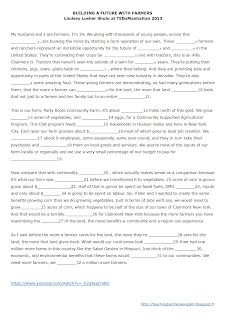A listening to practice the vocabulary of farming and learn about the differences between traditional commodity corn farming and a new trend of young farmers, who grow vegetables and rear animals on pastures.
Lindsay Lusher delivers a very inspiring speech on organic farming (without ever mentioning the word organic). In the extract I have picked, her focus is on the benefits for the community in terms of jobs and profits for example. She presents her farm, where she produces eggs and grows vegetables with an Allis-Chalmers G tractor, and then she goes on comparing it to growing commodity corn.
This is the second listening activity that I make from a TEDx conference - the first being Pushing the Boundaries in Agriculture. It can be used as a conclusion after studying general farming vocabulary with parody songs and after they created their farmer profile.
This is the second listening activity that I make from a TEDx conference - the first being Pushing the Boundaries in Agriculture. It can be used as a conclusion after studying general farming vocabulary with parody songs and after they created their farmer profile.
1. Listening
This listening is a good way to practice general farming vocabulary such as to grow, to produce, to cultivate, to feed, different animal names, grass, corn, a farmer, a farm operation, land, acres, input... But also more business orientated vocabulary: to provide jobs, to gross, to maximize the value, to spend (money) on... (labour, fossil fuels), benefits, a paycheck, employees, seasonally, year-round, goods and services, a percentage, a budget...
2. Reading
After they complete the gap-fill exercise, they can work on a more in-depth comprehension of the transcript, and notably the differences between the two farming models. This can be achieved by getting the students to fill out a double-entry chart: on the left side Ben and Lindsay's organic farm and on the right side commodity corn farming. That would allow them to contrast the information provided about both models like the profits, the size, the number of jobs created...
3. Worksheet
BUILDING A FUTURE WITH FARMERS
- From the title and the words below imagine what the talk is about.
food, local job creation, by hand, community, commodity corn, fossil fuel, GMO, input, a million more farmers
- Listen and take notes. Then complete the transcript.
- Comparing two farming models
Lindsay
|
Commodity corn
| |
………………….
|
Corn
| |
………………….
|
25 acres
|
25 acres
|
Gross Income
| ||
Number of employees/amount spent on labour
| ||
……………………………………………………………………………...
|
N/A
|
5000 acres, half of the size of Clairmont New York
|
Budget expenditures
| ||
Benefits for the community
|
- Speaking and writing:
- “The more farmers you have maximizing the value of the land, the more benefits a community can experience.”
- What kind of benefits is she talking about?
- “The more a farmer can care for the land, the more that land gives back.”
- How does a farmer care for the land?
- How does the land give back?
- “We need farmers, we need a million more farmers.”
- Why would having a million more farmers be a good thing for rural areas?
- What is wrong with the commodity corn system according to her?
- You interview Lindsay and her husband. Write the questions and answers using her talk.
It is also a good opportunity to review the difference between need, can and able to.
Worksheets and audio
This is the video extract that I use in this lesson:
But the full video can be watched by clicking on the link below:
Here is the transcript / gap-fill exercise and the worksheet:


No comments:
Post a Comment